
FNR-101

Timber harvesting provides an estimated 50 million dollars income to Indiana woodland owners each year. Much of this income is attributed to harvests on small, private, nonindustrial woodlands. Intervals between harvests are often long, and ownership changes may occur. Consequently, many woodland owners are not familiar with timber harvesting (harvesting includes the cutting and removal of trees from the woods) or the appearance of the residual forest following harvesting. This publication will discuss woodland ownership objectives, the steps involved in timber removal, alternatives for harvesting residue, and timber harvesting considerations.
Woodland ownership objectives are many and varied. In most situations, these objectives are at least compatible with or necessitate some timber harvesting. Examples of woodland management objectives compatible with timber harvesting include: maximizing dollar returns from the forest, placing the stand in good condition for future growth, protecting immature timber while removing mature trees, protecting forested watersheds, removing dead and dying trees, extending wildlife habitat, enhancing forest recreation, and removing trees in a prescribed manner for a homesite. A need for income may not be the primary objective for timber harvesting. Whatever the reasons for timber harvesting, however, it is important that the woodland owner, who sells and subsequently has timber harvested from his woodland, understand the timber harvesting process and the resulting condition of the residual forest.
Most timber in Indiana is cut by a professional logger. At present very little timber is removed by farmers or others working on a part-time basis. Loggers are usually independent businessmen who purchase timber, harvest it, and sell the logs to sawmills or veneer mills. Loggers may also contract with mills to cut and haul timber which the mills have purchased. In some cases, sawmills and veneer mills maintain their own logging crews. The typical logging crew will consist of at least one tree feller and one skidder operator. The feller's responsibility is to cut trees and prepare them for removal (Figure 1). Each tree is felled and the limbs and top cut from the merchantable bole. In most cases, the entire merchantable portion of the tree is skidded in tree lengths to the landing, a log concentration area, and then is bucked into logs. Sometimes individual logs are cut from the tree in the woods.
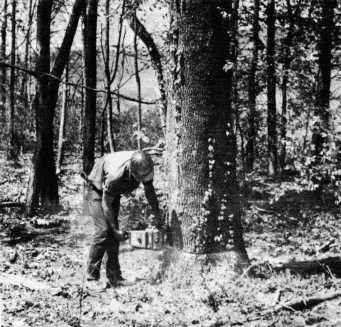
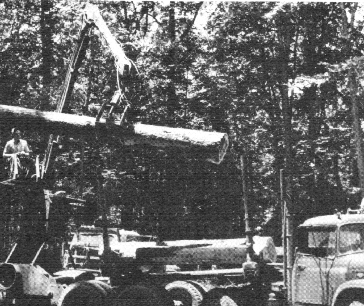

The skidder operator's responsibility includes moving or "skidding" the log from the woods to a landing. Several logs may be taken in one trip (Figure 2). When an appreciable number of logs (volume) accumulate at the landing, they are loaded on a truck, usually with a front-end loader (Figure 3), and taken to a sawmill or other primary log processor.
Logging is dangerous, expensive, and hard work. Because of the constant dangers involved, insurance rates are high. Logging equipment is expensive and costly to maintain. A commercial size chain saw may cost $400 or more, and the average skidder retails at $40 to 60 thousand. To make adequate profits, loggers must remove large volumes of timber in short time periods, meaning that he often cannot wait for ideal logging situations with respect to weather and soil conditions.
Besides removing the timber, there are other important aspects to a logging job. Many are of extreme importance to the landowner since they influence the potential value of any remaining timber. For example, when timber is harvested, a landing site must be selected, skid trails will be developed, and in large tracts, timber access roads may be required. Care must be taken to avoid damage to valuable residual trees during felling and skidding. The quality of harvesting work will depend upon how experienced the logger is and upon the amount of care he takes. Like other professionals, loggers vary tremendously in their work habits. Therefore, when signing a timber sale contract, the landowner should have an understanding in writing as to how all major aspects of the cutting operation will be performed and what compensation will result if the contract terms are violated.
Topography will often dictate the approximate location and the extent of a road system necessary to bring timber out of the woods. In other cases, property lines, economic limits on skidding distances, and other features may determine to what point a truck road shall be extended into the timber. When required, roads occupy from 6-16% of the harvested forest area and are often a source of erosion. Their proper location and maintenance are important. Generally the haul road will be planned to the fartherest point consistent with good economics and sound operating principles.
The slope of a road is called grade and this incline is expressed in percent. For example, a 10% grade is one that goes up or down 10 feet for every 100 feet of length. It is desirable to keep the grade of the logging road below 10%, though there are instances where this limit may be exceeded for short distances up to a maximum of about 20%. Logging roads should also avoid long steady grades. These permit the buildup of drainage water and increase the erosion potential unless adequate precautions are taken. To facilitate natural drainage, occasional breaks to level or adverse grade may be planned. Logging roads located in hilly country are usually placed on side hill positions. Such locations permit good cross drainage. They also provide the construction advantage of balanced cross sections which involve a minimum of earth moving. In the flat lands, it is desirable to improve drainage by avoiding long level sections of road. Grades of 3-5% are the most desirable.
Streambeds should not be used for roads. Disturbance can cause accelerated erosion and sedimentation as well as destruction of the plant and animal life in the stream itself. Road surface drainage should be kept out of the streams by locating the road far enough from a stream to provide sufficient filtering area (Figure 4). The width of the required filtering strip between the road and stream will vary according to particular site conditions. As a general
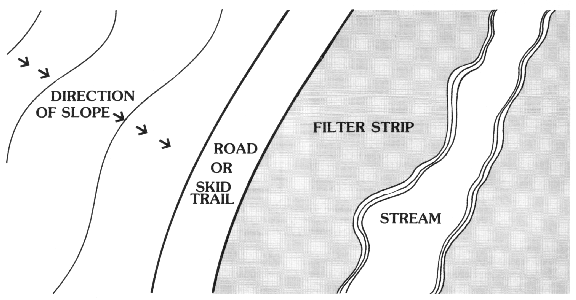
guideline in Appalachian-type terrain, the U.S. Forest Service has suggested the widths presented in Table- 1.
Average percent slope
between road Filter strip
and watercourse width (feet)
-------------------------------------------
0 25
5 35
10 45
15 55
20 65
25 75
30 85
35 95
40 105
45 115
The building of logging roads does not require a highway engineer but basic construction principles should be followed. The logging roads on small woodland properties are usually constructed by the logger. After the proposed road has been marked, the right-of-way must be cleared of trees. Merchantable trees are cut down and bucked into logs ahead of construction. The logs and tops will be moved far enough off the right-of-way so that they will not interfere with construction or subsequent road use. Stumps which will be covered by a foot or more of fill material may be cut low and will not need to be removed. All other stumps and roots over 3 inches in diameter should be dug out of the ground.
After the logging operation, maintenance of the logging road is left up to the owner. Maintenance problems are relatively minor with properly located and well constructed roads. Good judgment should be used in keeping off the roads during the spring breakup, or thaw, and during extended periods of wet weather. Periodic grading of the road surface is necessary to fill in wheel ruts and to shape the road. Immediately after logging, if the road will not be used for a period, water control devices such as culverts, which require periodic inspection and cleaning, should be replaced with water bars or other maintenance-free water control structures. Examples of water control devices are shown in Figures 5 and 6. Their number and spacing depends upon the grade of the road, slope. and condition of the watershed, and the erodability of the soil (Table 2).
Road grade Spacing
-----------------------------------
Percent Feet
2 - 5 300 - 500
6 - 10 200 - 300
11 - 15 100 - 200
16 - 20 Max. 100
--------------------------------------------
Note: Actual distances between culverts will depend upon the nature
of the road surface material and its tendency to erode.
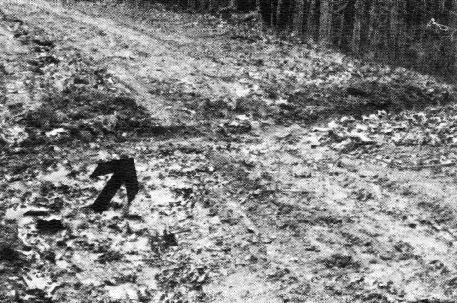
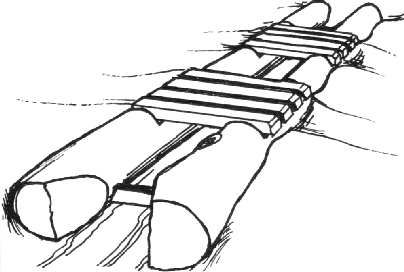
Natural revegetation of roads, ditches and landings with grasses and weeds will help prevent erosion. The type of grass and the rate of seeding will vary, but tall fescue or red fescue sown at a 10-15 lbs./ acre rate generally provides adequate coverage and stabilization of logging roads and skid trails. Where possible, the bare roadbed should be lightly disked and fertilized (200 lbs./acre of 5-20-20) before a broadcast seeding. Because roads present a forest edge and openings to game birds and animals, preference may be given in seeding to cover species that are beneficial to wildlife. If it is decided that the road will be kept open after logging, then it would be advisable to follow these simple rules to protect the road: 1) keep travel to a minimum, 2) use it only during dry weather or when the soil is frozen, 3) make periodic inspections, and follow through with simple maintenance.
Skidding of logs is performed in a variety of ways, depending upon the locality and the economic circumstances of the operator. The most common method skids one or more logs or entire trees by a rubber-tired skidder (Figure 2). These machines operate successfully over steep terrain and on poorly developed trails. Trails which are used to move logs from the stump to the main skid road are usually not graded and need only a minimum amount of clearing. Where skidding is contemplated by tractor equipment with a winch, logs are moved directly from the stump to tractor road without skid trails. Skid trails that run straight up and down the hillsides should be avoided. Steep trails cause eroding gullies and deposits of sediment at the foot of the slope and in streams. Skid trails should also avoid streambeds and rocky places. Where stream crossing is necessary, it should be at right angles to the stream. Breaks in grade should be made frequently and long, straight grades should be avoided. Otherwise, these conditions permit a build up in the volume and force of water and may cause or accelerate the rate of erosion.
Skid roads are a more developed form of a skid trail. Main skid roads should be flagged, cleared, and graded. The grade of the skid road should be kept as low as topography will permit by slanting up the hill. Where possible the skid road should be built from the top of the hill down.
Maintenance of skid roads during periods of use is usually confined to keeping the surface water drained off. At completion of the operation, however, certain steps should be taken to protect the road against erosion. These are: 1) the installation of permanent water control measures at necessary intervals to provide proper drainage, 2) the use of rocks, brush, and logging debris as water retardants on side trails, 3) the clearing of slash and the restoration to natural shape and grade of stream beds where skid roads cross streams or intermittent water courses, and 4) the seeding of landings and trail sections of extreme grade to provide early permanent vegetation cover.
A landing area will be required for concentrating logs and loading. The road approaching the landing should have a low grade. The timber length, loading method, and type of hauling equipment used will dictate landing requirements. The proper construction and maintenance of the landing site follows very closely that of the skid road location and maintenance. If tree length logs are brought to the landing and bucked, some defective material will result at the completion of the logging job. This material is usually piled and left to rot. It could be a good source of firewood.An illustration of how a forest may look in terms of roads, skid trails, and landings is shown in Figure 7.
In addition to the construction and maintenance of logging roads, skid trails, and landings, the professional logger will remove the trees with care to minimize the damage to the residual stand. How the residual stand appears will depend upon the type of harvesting system being practiced by the landowner and his forester.
In Indiana, the most common harvesting systems are clearcutting, shelterwood, selection, and partial cutting. Clearcutting is the harvesting of all trees of an area in one cut to create a new even-aged stand. The area harvested is large enough that open conditions are created. Regeneration is obtained through natural seeding, sprouting of trees that were in the stand, or by planting or direct seeding. Clearcutting favors the regeneration of sun-loving tree species, such as yellow poplar and aspen, and is necessary to release advanced oak regeneration. Also, clearcutting may be the safest way to harvest a stand of mature or overmature trees because partial cutting would leave the remaining large trees vulnerable to windthrow.
Economically, clearcutting is most efficient for the logger because all trees are removed, and the feller and skidder operator are not continually confronted with avoiding trees not to be harvested. The large volumes of material per unit area removed require more trips by the skidder, thus causing the greatest disturbance to the forest litter and underlying forest soil of all harvesting systems. Also, because there is no residual stand left after harvesting, the site is exposed (until revegetated) to the direct impact of raindrops and subsequent potential erosion. However, after this initial disturbance a long period of time is available for site recovery before the next timber harvest. With few exceptions, sites are usually stabilized within 2 or 3 years.
In shelterwood harvesting, the mature stand is removed in a series of cuts. Regeneration of the new stand occurs under the cover of a partial forest canopy. The final harvest cut removes the sheltering canopy and permits the new existing stand to develop in the open as an even-aged stand.
Shelterwood harvesting provides a partial, continuing cover of either large or small trees. Consequently some residual trees are damaged during each cut. Because the series of harvest cuts is usually closely spaced in time, the large trees damaged in cutting can be harvested in the following cutting with little loss to disease and insects in the intervening time interval. Generally the overabundance of regeneration in the understory is not severely damaged if care is taken in felling and skidding. Because of the continual forest canopy present on the site, the potential for direct soil disturbance during and following any one cutting is less than during clearcutting, but several closely spaced harvest cuts to remove all of the overstory may disturb the site considerably.
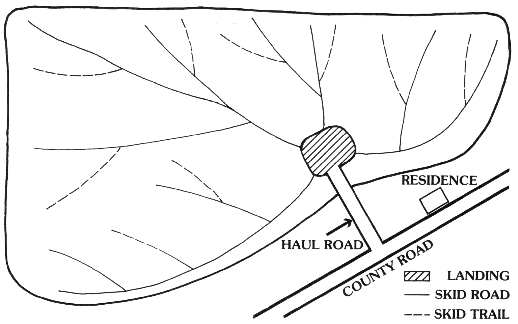
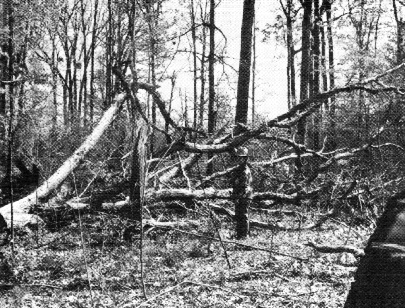
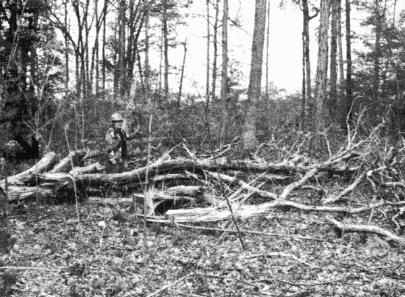
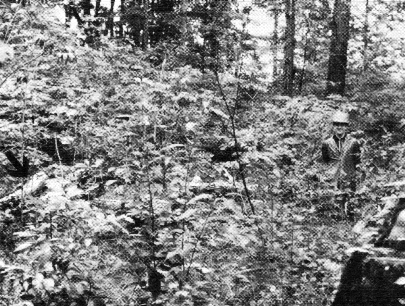
Selection
Selection harvesting involves the removal of mature or immature trees either singly or in groups at somewhat regular time intervals from a forest stand. Natural regeneration is established almost continuously. The objective of this harvesting system is the development and maintenance of an uneven-aged stand with trees of different ages or sizes intermingled singly or in groups.
The two types of selection harvesting are individual tree selection and group selection. Individual (single) tree selection involves the removal of individual trees, while group selection may remove several adjacent trees covering a small fraction of an acre or larger numbers of trees covering areas as large as an acre or two. Group selection is distinguished from clearcutting in that the intent of group selection is ultimately to create a balance of age or size classes in a mosaic of small contiguous groups throughout the forest stand. Single tree selection is aesthetically pleasing because larger trees and at least a partial overstory canopy are always present after harvesting. Single tree selection harvesting is least efficient for the logger because relatively small volumes of timber are harvested per unit of forest area. In addition, the large number of residual trees not harvested must be protected from felling and skidding damage during harvesting. This requires both the feller and the skidder operator to work more closely and carefully. In general, the residual stand is most vulnerable to damage in single tree selection. Site disturbance is relatively minor; however, periodic, light, single tree selection harvests at close time intervals can result in almost continual site disturbance and stand damage, particularly if care is not taken during each harvesting operation.
Group selection combines some of the positive advantages of both single tree selection and clear-cutting. Like clearcutting, the harvesting is concentrated in designated areas. This is more efficient for the logger than covering the whole stand for isolated trees. On the other hand, large open areas are not present. An additional advantage is that group selection allows the forester to create microclimates ranging from shaded conditions in single tree selection to full sunlight conditions in clearcutting. This manipulation of possible environmental conditions allows the forester to tailor harvest cuttings so as to favor any of a wide variety of plant species for timber production and/or wildlife habitat.
The harvesting methods described above delibately harvest mature trees and/or thin intermediate age classes, regenerating a new age class to replace the old. However, landowners frequently partially cut stands as a harvesting method without the deliberate effort to thin immature age classes or to regenerate a new crop.
These partial cuttings often take the form of diameter-limit cuttings in which all trees of a specified diameter and larger are cut. A second type of partial cutting removes only the large, higher quality trees of sawtimber size, leaving an irregularly spaced residual stand without any particular balance or design. Both of these types of cuttings are undesirable because they "high grade" the woods. That is, the largest, best formed, and most valuable species are removed, leaving a forest stand of lower value and generally lower vigor.
The logging operation will usually leave behind treetops and limbs. Some landowners find this logging slash objectionable (Figure 8a). Consequently, a landowner may want the tops cut up or lopped so that they lay flat on the ground and decay rapidly (Figures 8b, 8c). Top lopping requires additional production time on behalf of the logger. Therefore, a substantially lower stumpage price should be expected if the timber sale contract requires top lopping. A concerned landowner or logger who contract to include top lopping with the logging job may wish to consider employing an independent "top lopper" with a chain saw following completion of the commercial logging job. A third alternative for the landowner is to cut the tops for firewood or to lop them himself. For example, an 18 inch diameter at breast height (DBH) oak tree with 2 merchantable 12 foot logs contains approximately 800 lbs. of dry topwood (approximately 1/5 cord) 4 inches in diameter and greater.
While not necessarily pleasing to the eye, logging slash provides cover for much of the woods and edge species of wildlife. Slash is suitable cover for rabbits, ground squirrels, and chipmunks. Hollow stumps, logs, and tops offer cover for skunks, weasels, etc. In addition, tops and other logging slash piled along the edge of a woods become nesting sites for some species of songbirds and winter cover for pheasants and bobwhite quail.
Logging slash can be detrimental in regenerating a forest. Vines and other plants can quickly gain an advantage over young trees by using cut treetops for support, particularly on bottomland and other fertile sites. These fast growing competitors can form a dense canopy over the young trees and stop successful forest regeneration efforts for many years. To rectify such an adverse regeneration situation may require considerable time and expense. In these potential situations, top lopping or actual physical removal of treetops following logging may be necessary to insure successful forest regeneration.
The Timber Harvesting Contract Timber harvesting, like any other business transaction, requires a contract. A timber sale contract usually includes the total value of the sale, the trees designated to be cut, the location of the area to be harvested, and the date by which the timber is to be cut. The seller can impose additional restrictions. For example, he may specify the location and method of construction for landing sites and logging roads as well as impose penalties for damaged residual trees or removal of unmarked trees. The contract can also prescribe the conditions of woods roads after the logging job is completed. The landowner should remember, however, that too many restrictions placed on a logger, can lower the price received for standing timber, although possibly insuring a more desirable logging job. In some cases, severe restrictions can even make stumpage unsalable. Common sense by the landowner, forester, timber buyer, and logger can alleviate most problems.
It is important that the woodland owner first determine his ownership objectives. Then, if he decides to market and sell his timber and subsequently has it harvested, he should understand the timber harvesting process, the resulting condition of the residual forest, and how a properly negotiated timber harvesting contract can result in a satisfactory logging job.
Related Publications The following publications are available from Mailing Room, Agricultural Administration Building, Purdue University, West Lafayette, IN 47907 or from your county Extension agent.
FNR-88 Forestry and Water Quality: Pollution Control Practices
FNR-89 Criteria for Evaluating Forestry Activities in Relation to Water Control Management
RR 9/93
Cooperative Extension Work in Agriculture and Home Economics, State of Indiana, Purdue University and U.S. Department of Agriculture Cooperating. H.A. Wadsworth, Director, West Lafayette, IN. Issued in furtherance of the Acts of May 8 and June 30, 1914. It is the policy of the Cooperative Extension Service of Purdue University that all persons shall have equal opportunity and access to our programs and facilities.